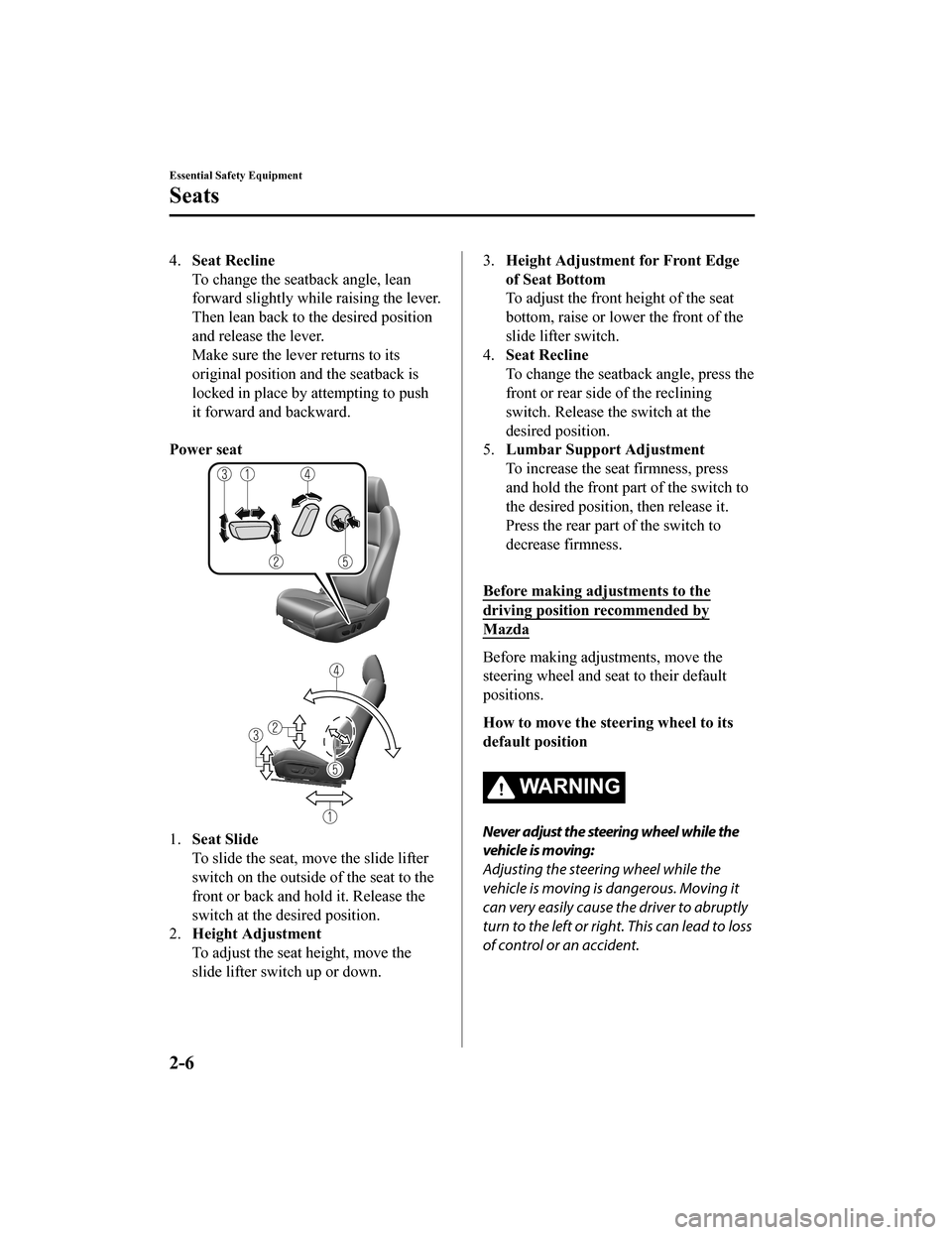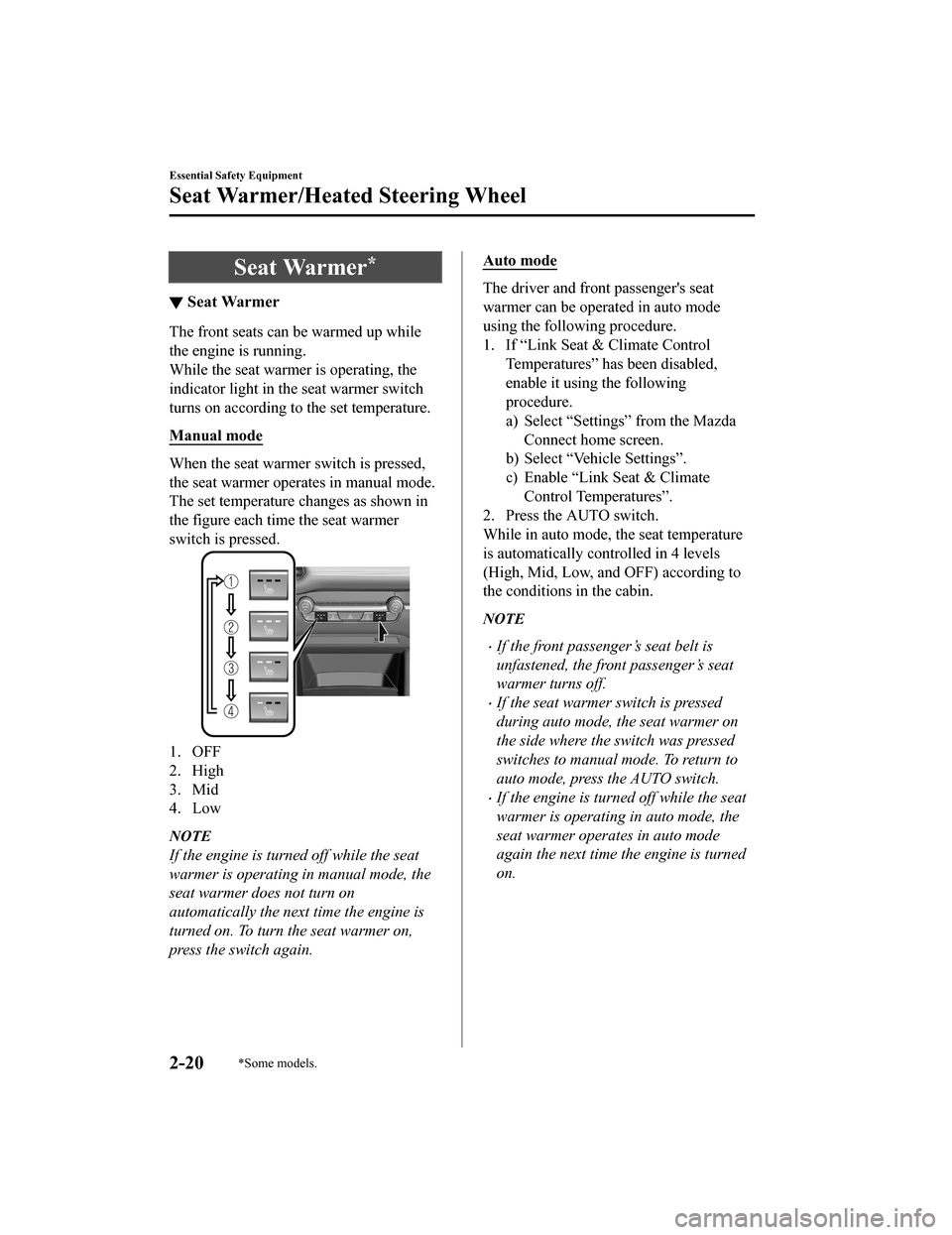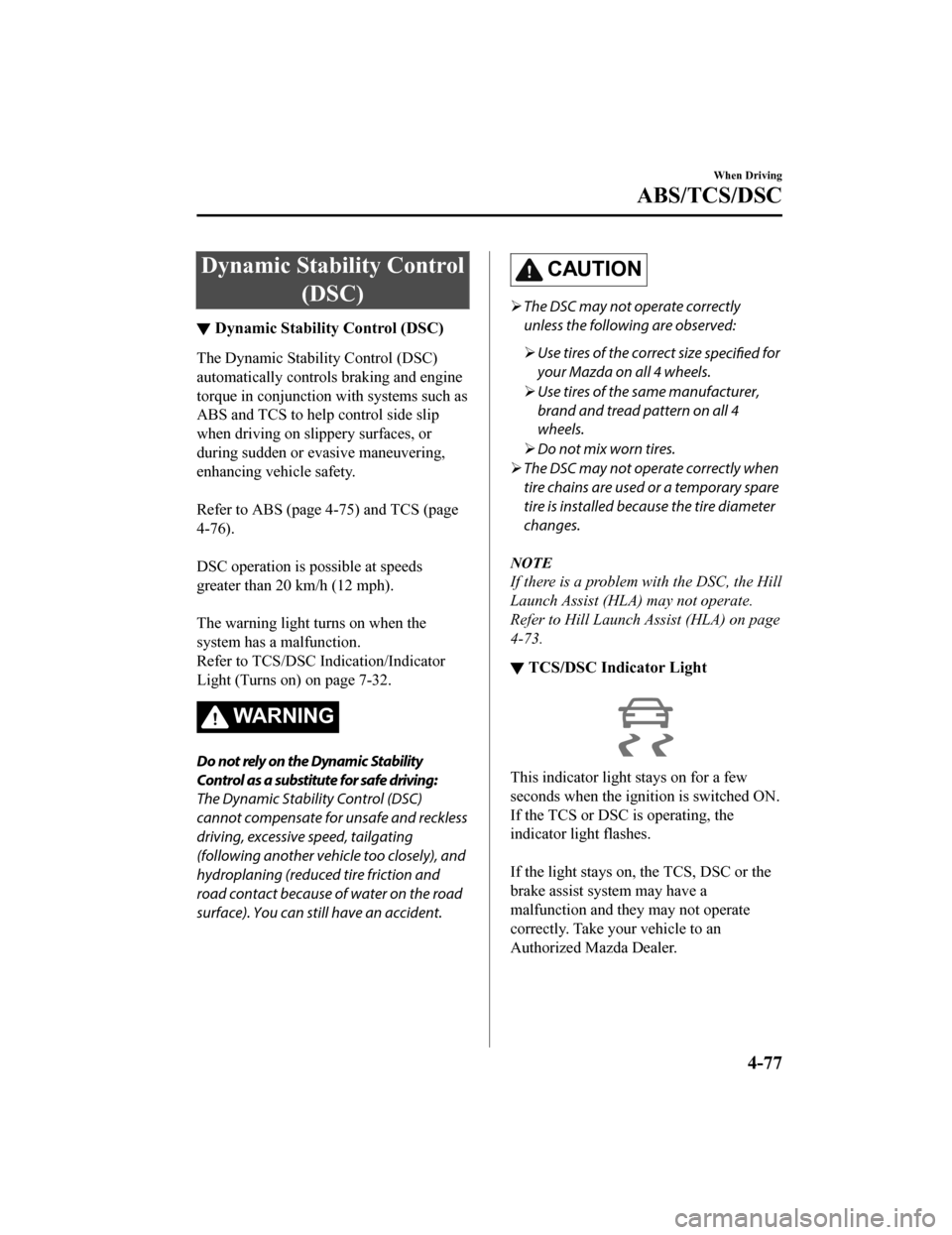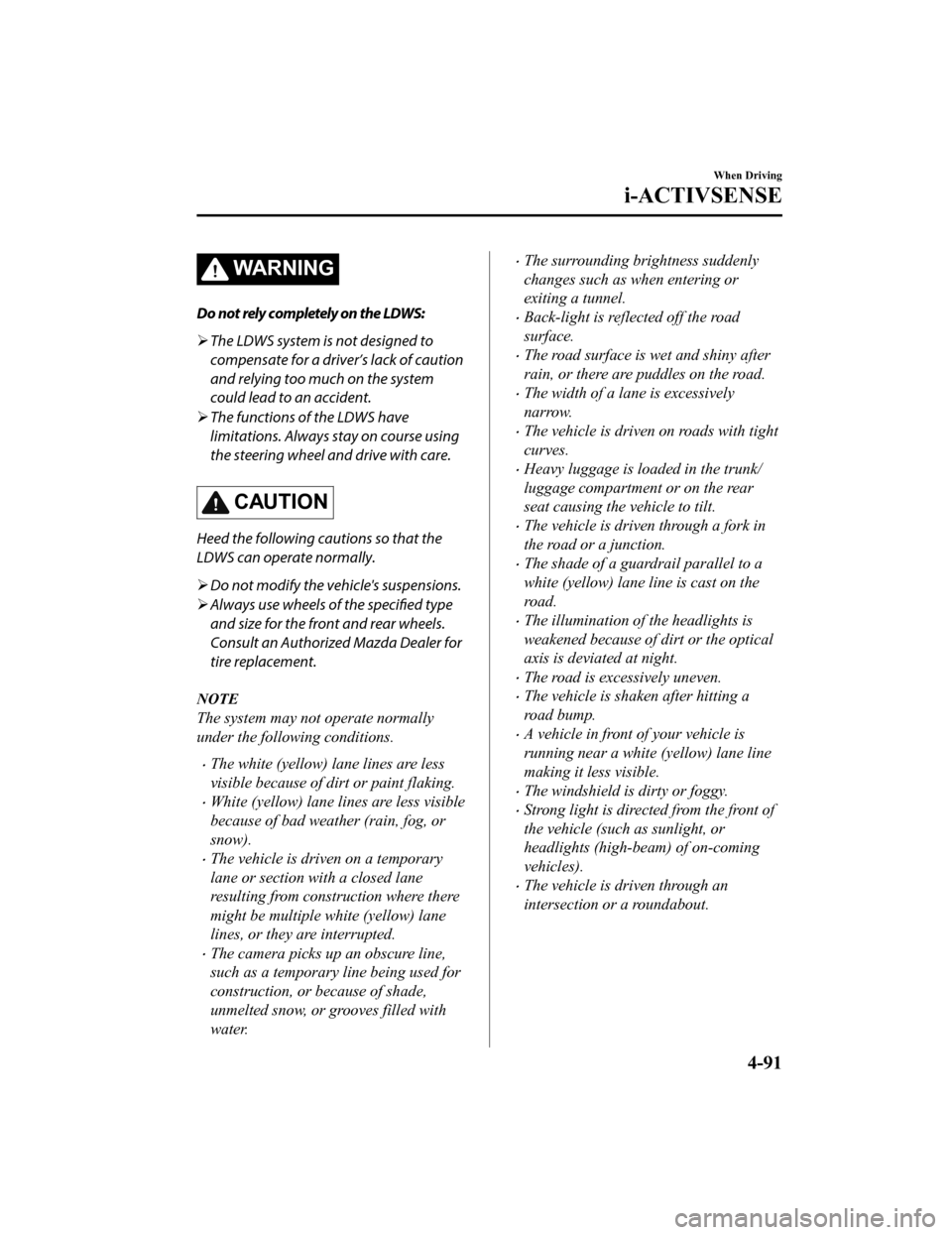change wheel MAZDA MODEL 3 HATCHBACK 2020 Owners Manual (in English)
[x] Cancel search | Manufacturer: MAZDA, Model Year: 2020, Model line: MODEL 3 HATCHBACK, Model: MAZDA MODEL 3 HATCHBACK 2020Pages: 598, PDF Size: 89.37 MB
Page 22 of 598

4.Seat Recline
To change the seatback angle, lean
forward slightly while raising the lever.
Then lean back to the desired position
and release the lever.
Make sure the lever returns to its
original position and the seatback is
locked in place by attempting to push
it forward and backward.
Power seat
1. Seat Slide
To slide the seat, m ove the slide lifter
switch on the outside of the seat to the
front or back and hold it. Release the
switch at the desired position.
2. Height Adjustment
To adjust the seat height, move the
slide lifter switch up or down.
3.Height Adjustment for Front Edge
of Seat Bottom
To adjust the front height of the seat
bottom, raise or lower the front of the
slide lifter switch.
4. Seat Recline
To change the seatback angle, press the
front or rear side of the reclining
switch. Release the switch at the
desired position.
5. Lumbar Support Adjustment
To increase the seat firmness, press
and hold the front part of the switch to
the desired position, then release it.
Press the rear part of the switch to
decrease firmness.
Before making adjustments to the
driving position recommended by
Mazda
Before making adjustments, move the
steering wheel and s eat to their default
positions.
How to move the steering wheel to its
default position
WA R N I N G
Never adjust the steering wheel while the
vehicle is moving:
Adjusting the steering wheel while the
vehicle is moving is dangerous. Moving it
can very easily cause the driver to abruptly
turn to the left or righ t. This can lead to loss
of control or an accident.
Essential Safety Equipment
Seats
2-6
Mazda3_8HZ1-EA-19G_Edition1_old 2019-5-17 13:49:03
Page 36 of 598

Seat Warmer*
▼Seat Warmer
The front seats can be warmed up while
the engine is running.
While the seat warme
r is operating, the
indicator light in the seat warmer switch
turns on according to t he set temperature.
Manual mode
When the seat warmer switch is pressed,
the seat warmer operates in manual mode.
The set temperature changes as shown in
the figure each time the seat warmer
switch is pressed.
1. OFF
2. High
3. Mid
4. Low
NOTE
If the engine is turned off while the seat
warmer is operating in manual mode, the
seat warmer does not turn on
automatically the next time the engine is
turned on. To turn the seat warmer on,
press the switch again.
Auto mode
The driver and front passenger's seat
warmer can be operated in auto mode
using the following procedure.
1. If “Link Seat & Climate Control Temperatures” has been disabled,
enable it using the following
procedure.
a) Select “Settings” from the MazdaConnect home screen.
b) Select “Vehicle Settings”.
c) Enable “Link Seat & Climate Control Temperatures”.
2. Press the AUTO switch.
While in auto mode, th e seat temperature
is automatically controlled in 4 levels
(High, Mid, Low, and OFF) according to
the conditions in the cabin.
NOTE
If the front passenger’s seat belt is
unfastened, the front passenger’s seat
warmer turns off.
If the seat warmer switch is pressed
during auto mode, the seat warmer on
the side where the switch was pressed
switches to manual mode. To return to
auto mode, press the AUTO switch.
If the engine is turned off while the seat
warmer is operating in auto mode, the
seat warmer operates in auto mode
again the next time the engine is turned
on.
Essential Safety Equipment
Seat Warmer/Heated Steering Wheel
2-20*Some models.
Mazda3_8HZ1-EA-19G_Edition1_old 2019-5-17 13:49:03
Page 137 of 598

WA R N I N G
Never stop the engine when going down a
hill:
Stopping the engine when going down a
hill is dangerous. This causes the loss of
power steering and power brake control,
and may cause damage to the drivetrain.
Any loss of steering or braking control
could cause an accident.
Hazardous Driving
▼Hazardous Driving
WA R N I N G
Be extremely careful if it is necessary to
downshift on slippery surfaces:
Downshifting into lower gear while driving
on slippery surfaces is dangerous. The
sudden change in tire speed could cause
the tires to skid. This could lead to loss of
vehicle control and an accident.
When driving on ice or in water, snow,
mud, sand, or similar hazards:
Be cautious and allow extra distance for
braking.
Avoid sudden braking and sudden
maneuvering.
Do not pump the brakes. Continue to
press down on the brake pedal.
Refer to Antilock Brake System (ABS)
on page 4-75.
If you get stuck, select a lower gear and
accelerate slowly. Do not spin the front
wheels.
For more traction in
starting on slippery
surfaces such as ice or packed snow, use
sand, rock salt, chains, carpeting, or
other nonslip material under the front
wheels.
NOTE
Use snow chains only on the front wheels.
Before Driving
Driving Tips
3-45
Mazda3_8HZ1-EA-19G_Edition1_old 2019-5-17 13:49:03
Page 180 of 598

M (Manual)
M is the manual shift mode position.
Gears can be shifted up or down by
operating the selector lever.
Refer to Manual Shift Mode on page
4-36.
▼Shift Position Indication
1. Shift position indication
The selector position is indicated when the
ignition is switched ON.
Gear position indication
In manual shift mode, the “M” of the shift
position indication illuminates and the
numeral for the selected gear is displayed.
▼ Active Adaptive Shift (AAS)
Active Adaptive Shift (AAS)
automatically controls the transmission
shift points to best suit the road conditions
and driver input. This improves driving
feel. The transmission may switch to AAS
mode when driving up and down slopes,
cornering, driving at
high elevations, or
depressing the accelerator pedal quickly
while the selector lever is in the D
position. Depending on the road and
driving conditions/vehicle operations, gear
shifting could be delayed or not occur,
however, this does not indicate a problem
because the AAS mode will maintain the
optimum gear position.
Manual Shift Mode
▼ Manual Shift Mode
The manual shift mode gives you the feel
of driving a manual transmission vehicle
by allowing you to operate the selector
lever manually. This allows you to control
engine rpm and torque to the drive wheels
much like a manual transmission when
more control is desired.
To change to manual shift mode, shift the
lever from D to M.
NOTE
Changing to manual shift mode while
driving will not damage the
transmission.
If you change to manual shift mode
when the vehicle is stopped, the gear
will shift to M1.
If you change to manual shift mode
without depressing the accelerator pedal
when driving in D range, 5th gear/6th
gear, the gear will shift to M4/M5.
To return to automatic shift mode, shift the
lever from M to D.
When Driving
Automatic Transmission
4-36
Mazda3_8HZ1-EA-19G_Edition1_old 2019-5-17 13:49:03
Page 183 of 598

WA R N I N G
Do not use engine braking on slippery road
surfaces or at high speeds:
Shifting down while driving on wet, snowy,
or frozen roads, or while driving at high
speeds causes sudden engine braking,
which is dangerous. The sudden change in
tire speed could cause the tires to skid. This
could lead to loss of vehicle control and an
accident.
Keep your hands on the steering wheel rim
when using fingers on the steering shift
switches:
Putting your hands inside the rim of the
steering wheel when using the steering
shift switches is dangerous. If the driver's
air bag were to deploy in a collision, your
hands could be impacted causing injury.
NOTE
When driving at high speeds, the gear
may not shift down.
During deceleration, the gear may
automatically shift down depending on
vehicle speed.
When depressing the accelerator fully,
the transmission will shift to a lower
gear, depending on vehicle speed.
However, the gears do not kickdown
while the DSC is turned off.
▼ Second Gear Fixed Mode
When the selector lever is moved back +
while the vehicle speed is about 10 km/h
(6.2 mph) or less, the t
ransmission is set in
the second gear fixed mode. The gear is
fixed in second while in this mode for
easier acceleration from a stop and driving
on slippery roads such as snow-covered
roads.
If the selector lever is moved back + or
forward – while in the second gear fixed
mode, the mode will be canceled.
When Driving
Automatic Transmission
4-39
Mazda3_8HZ1-EA-19G_Edition1_old 2019-5-17 13:49:03
Page 221 of 598

Dynamic Stability Control(DSC)
▼Dynamic Stability Control (DSC)
The Dynamic Stability Control (DSC)
automatically controls braking and engine
torque in conjunction with systems such as
ABS and TCS to help control side slip
when driving on slippery surfaces, or
during sudden or evasive maneuvering,
enhancing vehicle safety.
Refer to ABS (page 4
-75) and TCS (page
4-76).
DSC operation is possible at speeds
greater than 20 km/h (12 mph).
The warning light turns on when the
system has a malfunction.
Refer to TCS/DSC Indication/Indicator
Light (Turns on) on page 7-32.
WA R N I N G
Do not rely on the Dynamic Stability
Control as a substitute for safe driving:
The Dynamic Stability Control (DSC)
cannot compensate for unsafe and reckless
driving, excessive speed, tailgating
(following another vehicle too closely), and
hydroplaning (reduced tire friction and
road contact because of water on the road
surface). You can still have an accident.
CAUTION
The DSC may not operate correctly
unless the following are observed:
Use tires of the correct size
specified for
your Mazda on all 4 wheels.
Use tires of the same manufacturer,
brand and tread pattern on all 4
wheels.
Do not mix worn tires.
The DSC may not operate correctly when
tire chains are used or a temporary spare
tire is installed because the tire diameter
changes.
NOTE
If there is a problem with the DSC, the Hill
Launch Assist (HLA) may not operate.
Refer to Hill Launch Assist (HLA) on page
4-73.
▼ TCS/DSC Indicator Light
This indicator light stays on for a few
seconds when the ignition is switched ON.
If the TCS or DSC
is operating, the
indicator light flashes.
If the light stays on, the TCS, DSC or the
brake assist system may have a
malfunction and they may not operate
correctly. Take your vehicle to an
Authorized Mazda Dealer.
When Driving
ABS/TCS/DSC
4-77
Mazda3_8HZ1-EA-19G_Edition1_old 2019-5-17 13:49:03
Page 223 of 598

Drive Selection*
▼Drive Selection
Drive selection is a system to switch the
vehicle's drive mode. When the sport
mode is selected, vehicle's response
against accelerator operation is enhanced.
This provides additional quick
acceleration which may be needed to
safely make maneuvers such as lane
changes, merging onto freeways, or
passing other vehicles.
CAUTION
Do not use the sport mode when driving on
slippery roads such as wet or snow-covered
roads. It may cause tire slipping.
NOTE
When the sport mode is selected, driving
at higher engine speeds increases and it
may increase fuel consumption. Mazda
recommends that you cancel the sport
mode on normal driving.
Drive mode cannot be switched in the
following conditions:
ABS/TCS/DSC is operating
Cruise control* is operating.
The Mazda Radar Cruise Control with
Stop & Go function (MRCC with Stop
& Go function) System
* is operating.
Traffic Jam Assist (TJA)* is operating.
Steering wheel is being operated
abruptly
▼Drive Selection Switch
Press the drive sele
ction switch forward
(SPORT) to select the sport mode.
Pull the drive selecti on switch back (OFF)
to cancel the sport mode.
NOTE
In the following cases, the drive
selection is canceled.
The ignition is switched OFF.
Cruise Control is set.
Mazda Radar Cruise Control with
Stop & Go function (MRCC with Stop
& Go function) is set.
Traffic Jam Assist (TJA) is set.
Depending on the driving conditions
when sport mode is selected, the vehicle
may perform shift-down or slightly
accelerate.
When Driving
Drive Selection
*Some models.4-79
Mazda3_8HZ1-EA-19G_Edition1_old 2019-5-17 13:49:03
Page 235 of 598

WA R N I N G
Do not rely completely on the LDWS:
The LDWS system is not designed to
compensate for a driver’s lack of caution
and relying too much on the system
could lead to an accident.
The functions of the LDWS have
limitations. Always stay on course using
the steering wheel and drive with care.
CAUTION
Heed the following cautions so that the
LDWS can operate normally.
Do not modify the vehicle's suspensions.
Always use wheels of the
specified type
and size for the front and rear wheels.
Consult an Authorized Mazda Dealer for
tire replacement.
NOTE
The system may not operate normally
under the following conditions.
The white (yellow) lane lines are less
visible because of di rt or paint flaking.
White (yellow) lane lines are less visible
because of bad weather (rain, fog, or
snow).
The vehicle is driven on a temporary
lane or section with a closed lane
resulting from construction where there
might be multiple white (yellow) lane
lines, or they are interrupted.
The camera picks up an obscure line,
such as a temporary line being used for
construction, or because of shade,
unmelted snow, or grooves filled with
water.
The surrounding brightness suddenly
changes such as when entering or
exiting a tunnel.
Back-light is reflected off the road
surface.
The road surface is wet and shiny after
rain, or there are puddles on the road.
The width of a lane is excessively
narrow.
The vehicle is driven on roads with tight
curves.
Heavy luggage is loaded in the trunk/
luggage compartment or on the rear
seat causing the vehicle to tilt.
The vehicle is driven through a fork in
the road or a junction.
The shade of a guardrail parallel to a
white (yellow) lane line is cast on the
road.
The illumination of the headlights is
weakened because of dirt or the optical
axis is deviated at night.
The road is excessively uneven.
The vehicle is shaken after hitting a
road bump.
A vehicle in front of your vehicle is
running near a white (yellow) lane line
making it less visible.
The windshield is dirty or foggy.
Strong light is directed from the front of
the vehicle (such as sunlight, or
headlights (high-beam) of on-coming
vehicles).
The vehicle is driven through an
intersection or a roundabout.
When Driving
i-ACTIVSENSE
4-91
Mazda3_8HZ1-EA-19G_Edition1_old 2019-5-17 13:49:03
Page 236 of 598

▼When the System Operates
When the ignition is switched ON, the
i-ACTIVSENSE status symbol (warning/
risk avoidance support system) (white)
turns on and the system goes on standby.
NOTE
If the i-ACTIVSENSE status symbol
(warning/risk avoidance support system)
(white) does not turn on, the system is
canceled using the i-ACTIVSENSE switch
or the personalization feature.
Operation conditions
When all of the foll
owing conditions are
met, the i-ACTIVSE NSE status symbol
(warning/risk avoidance support system)
on the multi-information display changes
from white to green and the system
becomes operational.
The ignition i s switched ON.
The vehicle speed is about 64 km/h (40
mph) or faster.
The system detects white (yellow) lane
lines.
NOTE
When the system does not detect a white
(yellow) lane line on one side only, the
system does not operate on the side that is
not being detected.
When temporarily canceling the system
The LDWS goes on standby in the
following cases: The LDWS operation is
automatically restored when the system's
operation conditions are met.
The system cannot detect white (yellow)
lane lines.
The vehicle speed is less than about 56
km/h (35 mph).
The turn signal lever is operated.
The accelerator pedal is depressed.
The steering wheel is operated.
The brake pedal is operated.
The function is temporarily stopped.
The LDWS stops functioning in the
following cases:
The temperature in the forward sensing
camera (FSC) is high or low.
The windshield around the forward
sensing camera (FSC) is foggy.
The windshield around the forward
sensing camera (FSC) is blocked by an
obstruction, causing poor forward
visibility.
When Driving
i-ACTIVSENSE
4-92
Mazda3_8HZ1-EA-19G_Edition1_old 2019-5-17 13:49:03
Page 237 of 598

Strong light (such as sunlight, or
headlights (high-beam) of on-coming
vehicles) is directed at the forward
sensing camera (FSC).
System malfunction
If there is a problem with the system, the
i-ACTIVSENSE status symbol (warning/
risk avoidance support system) (white)
and the i-ACTIV SENSE warning
indication/warning light on the
multi-information display turns on and a
message is indicated.
Refer to i-ACTIVSENSE Status Symbol
(Warning/Risk Avoidance Support
System) on page 4-85.
▼ LDWS Warning
If the system determines that the vehicle
may deviate from its lane, a warning (beep
sound, steering wheel vibration) is
activated and the direction in which the
system determines that the vehicle may
deviate is indicated on the
multi-information display.
NOTE
The LDWS settings can be changed.
Refer to the Settings section in the
Mazda Connect Owner's Manual.
You may not be able to hear the LDWS
warning sound depending on the
surrounding conditions such as outside
noise.
If you set the LDWS to vibrate the
steering wheel, you may not feel the
vibrations depending on the road
surface conditions.
▼Canceling the System
The LDWS can be set to inoperable.
(If only the LDWS is turned off)
Refer to the Settings section in the
Mazda Connect Owner's Manual.
(If the LDWS is
turned off by
operating the i-ACTIVSENSE switch)
Refer to i-ACTIV SENSE Switch on
page 4-87.
NOTE
If the ignition is switched OFF while you
have canceled the system using the
i-ACTIVSENSE switch, the system is
automatically enabled the next time the
ignition is switched ON. However, if the
system is canceled using the
personalization features, the system is not
automatically enabled.
When Driving
i-ACTIVSENSE
4-93
Mazda3_8HZ1-EA-19G_Edition1_old 2019-5-17 13:49:03